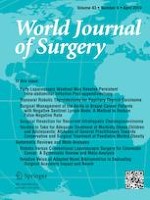Erschienen in:

07.12.2018 | Original Scientific Report
Prognostic Factors of Pathological N1 Non-small Cell Lung Cancer After Curative Resection Without Adjuvant Chemotherapy
verfasst von:
Youngkyu Moon, Sook Whan Sung, Jae Kil Park, Kyo Young Lee, Seha Ahn
Erschienen in:
World Journal of Surgery
|
Ausgabe 4/2019
Einloggen, um Zugang zu erhalten
Abstract
Background
The aim of this study was to evaluate the outcomes of patients with pathological N1 non-small cell lung cancer who did not receive adjuvant chemotherapy. We attempted to identify those patients for whom adjuvant chemotherapy would be indispensable.
Methods
Among 132 patients who were diagnosed with pathological N1 lung cancer at a single institution from January 2010 to December 2016 were 32 patients who did not receive adjuvant treatment after curative surgical resection. The surgical and oncological outcomes of these patients were analyzed. Candidate factors for predicting recurrence were analyzed to identify patients at high risk of recurrence.
Results
The median follow-up time for all 32 patients was 1044 days. The 5-year recurrence-free survival (RFS) and disease-specific survival rates of the patients without adjuvant therapy were 50.3% and 77.6%, respectively. By multivariate analysis, tumors with a lepidic growth pattern [hazard ratio (HR) 0.119, p = 0.024] and extralobar lymph node metastasis (HR 6.848, p = 0.015) were significant factors predicting recurrence. The difference between the 5-year RFS rates of patients with tumors with or without a lepidic growth pattern was statistically significant (63.5% vs 40.0%, respectively; p = 0.050). The 5-year RFS rates of patients with intralobar lymph node metastasis versus those with extralobar lymph node metastasis were 63.3% and 18.8%, respectively (p = 0.002).
Conclusions
Patients with tumors without a lepidic growth pattern or with extralobar lymph node metastasis who do not receive adjuvant chemotherapy have a high recurrence rate after surgery. Therefore, these patients should be encouraged to undergo adjuvant chemotherapy if their overall condition is not a contraindication for chemotherapy.